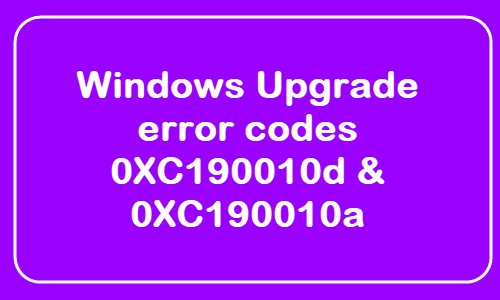Windows updates are generally bug-free but could sometimes come with a few like computers going slow. But that’s not common. Regarding the upgrade methods, the command line is a geek-favorite way to upgrade Windows. However, many users have complained of being unable to upgrade their machines using the command line. Whenever they attempt the upgrade, the error codes 0XC190010a or 0XC190010d show up. This scenario is mostly caused by incorrect command-line arguments, which is evident from the error messages:
0XC190010d MOSETUP_E_INVALID_CMD_LINE The installation process was launched with an invalid command-line argument.0XC190010a MOSETUP_E_UNKNOWN_CMD_LINE The installation process was launched with an unknown command-line argument.
Knowing that incorrect arguments cause the upgrade error 0XC190010a and 0XC190010d, the quickest way to resolve the issue is to upgrade Windows manually using the right procedure.
Windows Upgrade error codes 0XC190010d & 0XC190010a
Here are the steps for upgrading your Windows operating system manually. With the above course of action, you are sure to upgrade your Windows 10 edition without encountering the 0XC190010a or 0XC190010d errors. Please follow the given steps closely.
1] Ensure that you are using the correct command-line arguments
If you’re getting the 0XC190010a or 0XC190010d error codes when you deploy the Windows upgrade using command-line arguments, there’s an issue with the parameters you used. We noted this factor earlier in this post. To get rid of these errors, you have to do the installation or migration using the correct command-line arguments. Here is the list of arguments you can verify or check with.
2] Rebuild the SoftwareDistribution and Catroot2 folders
To rebuild the SoftwareDistribution and Catroot2 folders, first, press the Start button and search for PowerShell. Right-click on it, and choose to Run as administrator. In the PowerShell (Admin) window, enter the following commands. After every line below, hit the ENTER key to run it before proceeding to the next. After running the above commands, close PowerShell and restart your computer.
3] Rename the CBS.log file
Press the Windows key and type in the following string: It takes you to Local Disk (C:) > Windows > Logs > CBS.
Rename the CBS.log file to a CBSold.log. If you are unable to rename the CBS.log file, fix it with the steps below:
Press the Windows key + R combination to open the Run dialog box.Type Services.msc in Run and click OK.Find and double-click on the Windows Modules Installer service.Change the startup type to Manual.Restart your machine.
You should be able to rename the CBS.log file after following the above steps. When you rename it, return to the Windows Modules Installer service and change the startup type back to Automatic. Remember to reboot your PC after renaming the file.
4] Uninstall third-party antivirus software
After successfully renaming the CBS log file, the next step is to uninstall all third-party antivirus software you have installed on your computer. This is a preventive measure in case the antivirus is interfering with the Windows upgrade. It would be best if you always used your computer with antivirus software, constantly monitoring your data. Therefore, remember to install the antivirus after you complete this guide.
5] Download and install the latest Windows update
With the relevant files rebuilt and your antivirus uninstalled, you’re now set for the Windows upgrade. Now, visit the official Windows software download page and download the latest Windows 10 bits. On the Windows software download website, you can either click on the Update now button and follow the Upgrade Assistant or download the update file and use the media creation tool to perform the upgrade. Following the above steps in the guide, you’ll successfully upgrade your Windows system without encountering the error codes 0XC190010d & 0XC190010a.

